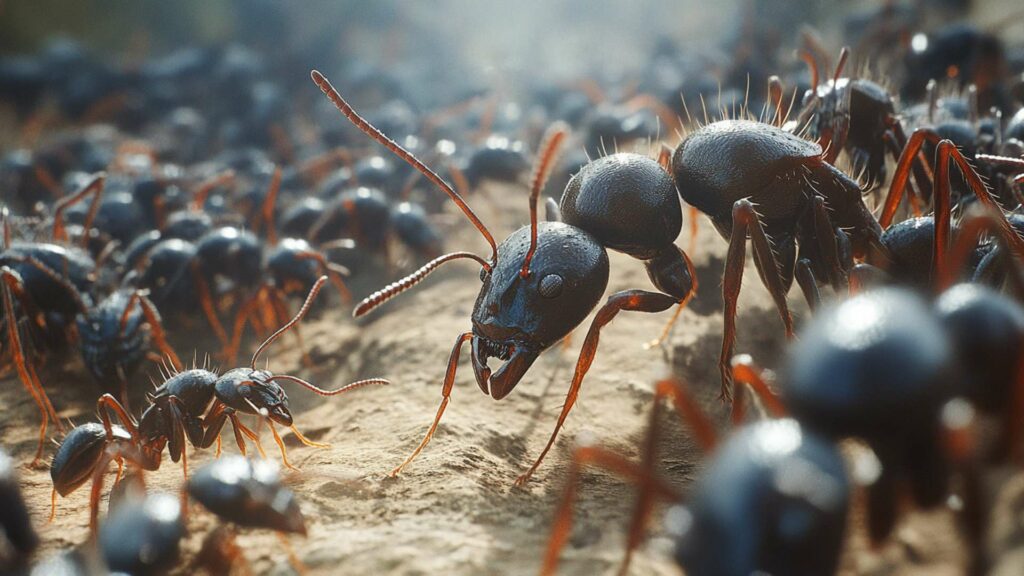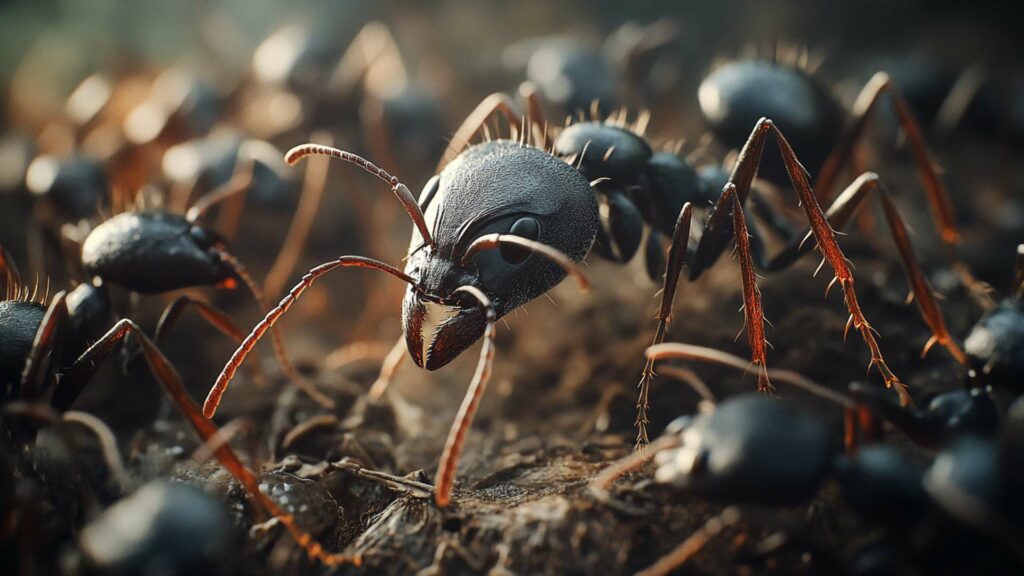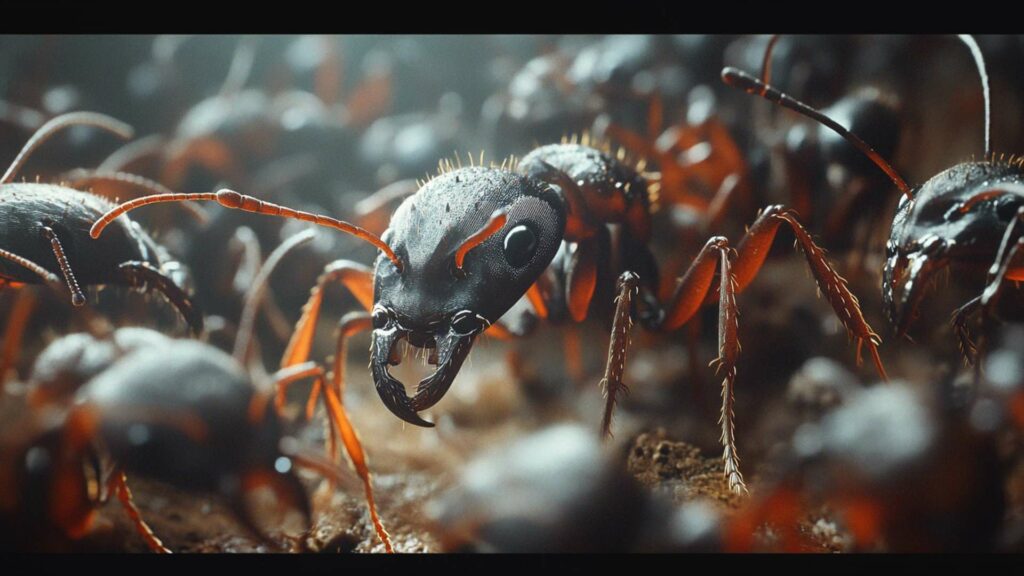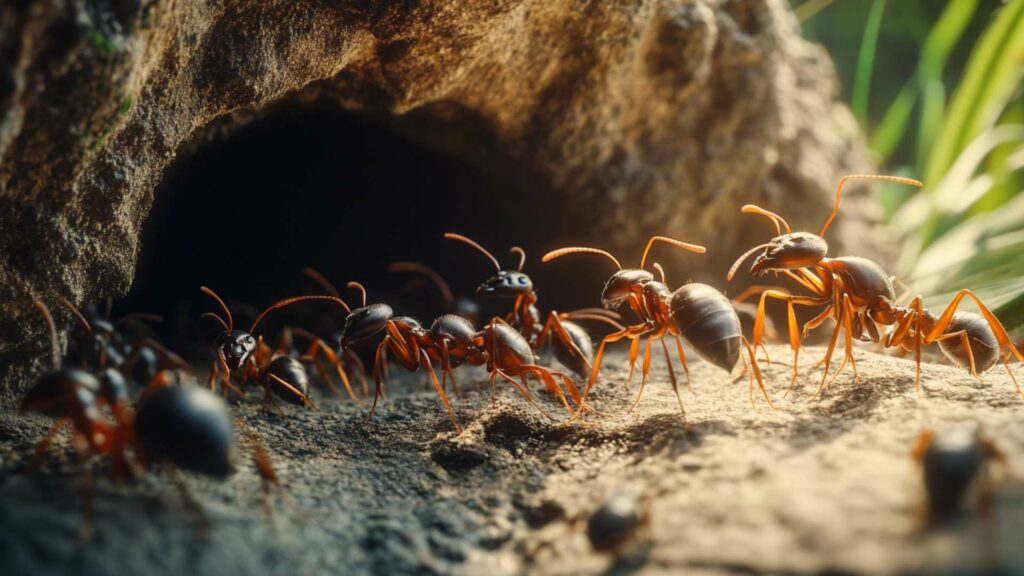In the vast realm of insects, there exist several fascinating species that captivate our attention with their unique characteristics and behaviors. One such intriguing insect is the fire ant. Found in various parts of the world, these tiny creatures have both intrigued and alarmed humans for centuries.
With their fiery nature and potent sting, fire ants have earned a reputation as formidable adversaries. Understanding their appearance plays a crucial role in identifying them correctly and dealing with potential encounters effectively.
The Multifaceted Nature of Fire Ants

Before we delve into the intricate details of what fire ants look like, let us first grasp a basic understanding of this intriguing species. The term “fire ant” actually encompasses multiple species belonging to the Solenopsis genus.
These resilient insects originated in South America but have managed to spread far beyond their native lands due to human activity and environmental factors. Fire ants are known for their aggressive behavior and highly organized social structure within colonies.
They are opportunistic omnivores, meaning they feast on various types of food including other insects, fly larvae, fruits, seeds, and even carrion. Their voracious appetite coupled with their ability to adapt makes them significant players in local ecosystems.
Why Appearance Matters
Now that we comprehend the broader context surrounding fire ants let us explore why understanding their appearance is essential. Identifying fire ants accurately can save us from painful encounters or potentially dangerous situations. Their painful sting can leave victims with serious swelling or even lead to severe allergic reactions in some individuals.
Additionally, recognizing fire ant mounds is crucial when it comes to preventing damage to property or agricultural areas. These industrious creatures construct large mounds made up of excavated soil which house their colonies beneath the surface.
By familiarizing ourselves with the distinct physical traits of fire ant s, we can differentiate them from other species, avoid inadvertent disturbances to their colonies, and take appropriate measures to handle any encounters effectively. With this knowledge in hand, let us embark on a journey through the intricate world of fire ant appearances.
General Characteristics of Fire Ants
Size and Color Variations: A Kaleidoscope of Fire Ants

When it comes to size and color, fire ants are an intriguing kaleidoscope of variations. These audacious insects can range in size from a minuscule 1/16th of an inch to a formidable 1/4th of an inch.
The workers, who do the heavy lifting in the colony, typically measure around 1/8th to 1/4th of an inch. However, don’t let their small stature deceive you – their mighty bite packs quite a punch!
As for color, fire ants exhibit diversity that rivals even the most vibrant palettes. While the quintessential red imported fire ants (Solenopsis invicta) boast a distinctive copper brown hue, other species showcase shades of reddish-brown, blackish-brown, or even reddish-black.
Body Structure and Segmentation: A Marvelous Insect Design

Fire ants possess a fascinating body structure that is intricately designed for survival and efficiency. Their bodies consist of three main sections: the head, thorax, and abdomen. These segments are connected by narrow waists that grant them flexibility for navigating through various terrains with remarkable agility.
Starting with their heads, fire ants have two long antennae protruding from the front like miniature divining rods. These sensitive appendages help them sense vibrations in the environment and detect chemical signals from other ants.
Moving down to the thorax, you’ll find six legs specifically adapted for diverse functions such as digging tunnels or clinging onto surfaces with tenacity. Additionally, certain members within a colony may possess wings during different stages of their life cycle—mainly queens and males during mating flights.
We reach the abdomen—the rearmost section responsible for housing vital organs and reproductive capabilities. The abdomen is divided into several segments, allowing fire ants to flexibly move and perform tasks efficiently.
At the posterior end of the abdomen, a venomous stinger rests, ready to defend the colony against any perceived threats. Understanding these general characteristics of fire ants provides a foundation for comprehending their appearance in more intricate detail.
Let’s now delve deeper into the features of their heads, where their senses come alive, and their thoraxes, which grant them remarkable mobility. Stay tuned for our next sections on “Head Features of Fire Ants” and “Thorax Features of Fire Ants,” where we will unveil even more astonishing traits that make these insects true marvels of nature!
Head Features of Fire Ants
Antennae: Shape, Size, and Function

When it comes to the head features of fire ants, one cannot overlook their fascinating antennae. These delicate sensory organs protrude from the ant’s head and serve a multitude of purposes.
The shape and size of the antennae may vary depending on the species and caste within a fire ant colony. Typically, fire ants have segmented antennae with an elbow-like bend.
The number of segments can differ but usually ranges from 10 to 12. At the tip of each segment are tiny sensory hairs that allow them to detect changes in their environment.
The length of the antennae also varies among individuals, with worker ants having shorter ones compared to reproductive ants. The function of fire ant antennae is vital for their survival and communication within the colony.
These remarkable appendages help them detect odors, vibrations, moisture levels, and even temperature fluctuations in their surroundings. By using their antennae as sensitive instruments, fire ants can navigate efficiently through their environment and locate food sources or communicate danger signals to other members of their colony.
Eyes: Compound Eyes and Their Role in Vision

Fire ants possess compound eyes located on either side of their head. These compound eyes are made up of numerous tiny lenses called ommatidia.
Unlike human eyes, which consist of a single lens that captures one image at a time, compound eyes allow for broader visual perception. While each ommatidium detects only a small portion of an image with limited resolution on its own, collectively they create a mosaic-like view that enables fire ants to perceive movement exceptionally well.
This adaptation is particularly useful for spotting potential threats or prey items while foraging or defending their nests. Although compound eyes provide valuable visual information to fire ants during daylight hours when they are most active, they have limited vision in low-light conditions or darkness.
In such situations, fire ants primarily rely on their other senses, including their antennae and sense of touch. Understanding the head features of fire ants, including their distinct antennae and compound eyes, helps us appreciate the remarkable adaptations these insects possess.
These sensory organs play a crucial role in their daily activities such as foraging for food, communicating with other members of the colony, and staying safe from potential dangers. As we delve deeper into the various physical characteristics of fire ants, we continue to unravel the intriguing world of these resilient creatures.
Thorax Features of Fire Ants
Legs: Number, Structure, and Adaptations for Movement
The thorax of fire ants is an essential part of their body, housing the legs that play a crucial role in their ability to move swiftly and efficiently. Fire ants possess six legs, three pairs in total, strategically located along the thoracic region. Each leg consists of several segments that provide flexibility and strength for various activities such as walking, climbing, and digging.
The structure of fire ant legs is fascinating. Each leg comprises coxae (the base), trochanter (which allows for flexion), femur (providing strength), tibia (allowing extension), and tarsus (the foot).
These segmented leg structures enable fire ants to navigate different terrains with remarkable agility. The powerful muscles attached to these segments aid in their rapid movements.
Fire ants have adapted their legs for specific functions. For instance, the hind legs are longer than the others, allowing them to perform remarkable jumps when necessary.
This adaptation assists them in escaping predators or traversing obstacles quickly. Additionally, these versatile appendages are vital during foraging expeditions as they help fire ant workers transport food back to their nests.
Wings: Presence or Absence in Different Castes

Unlike some other ant species, not all fire ants possess wings throughout their lives. The presence or absence of wings depends on the caste system within a fire ant colony.
The reproductive members of the colony known as alates are responsible for mating and establishing new colonies. Alates have wings which allow them to take flight during nuptial flights where they mate with members from other colonies.
These reproductive individuals include both males and females. On the other lawns other hand, worker fire ants do not have wings at any stage of their lives.
Worker ants are responsible for various tasks within the colony, such as foraging for food, caring for the brood, and maintaining the nest structure. Their specialized bodies prioritize efficiency and agility over flight capabilities.
It is interesting to note that fire ant workers are typically smaller in size compared to alates. The absence of wings allows them to navigate through narrow spaces more effectively, making them ideal for tasks that require frequent movement within the intricate tunnels of their nests.
Understanding the thorax features of fire ants sheds light on their remarkable adaptability and specialized functions within their colonies. Whether it’s their legs designed for swift movement or the presence or absence of wings based on caste differentiation, these physical attributes contribute to their survival and success as a species.
Abdomen Features of Fire Ants
Segmentation: Distinct Sections and Their Purposes
Fire ants, belonging to the genus Solenopsis, possess a well-defined abdominal structure that plays a vital role in their daily activities. The abdomen is composed of several distinct sections, each serving a unique purpose.
This segmentation allows fire ants to perform various functions necessary for survival and colony maintenance. The first section of the abdomen is called the petiole, which acts as a connection between the thorax and the gaster (the posterior part of the fire ant bite).
The petiole enables flexible movement and mobility, allowing fire ants to navigate different terrains efficiently. It also serves as an attachment point for muscles that control abdominal movement.
The gaster itself consists of several visible segments. These segments house vital organs such as the digestive system, reproductive organs, and venom glands.
The segmentation provides flexibility to fire ants when performing tasks like food storage or communicating through pheromones. Furthermore, it allows them to expand their abdomen significantly when carrying out essential functions such as reproduction or venom production.
Stinger: Location, Size, and Defensive Capabilities

One striking feature found in fire ants’ abdomens is their potent stinger located at the tip of the gaster. This formidable weapon is mainly used for self-defense against predators or threats posed to their colony. When provoked, disturbed, or threatened, fire ants will raise their abdomens upwards while curving their bodies forward to expose their stingers prominently.
The stinger itself is relatively large compared to other fire ant sting species but varies slightly in size among different fire ant species. For instance, red imported fire ants (Solenopsis invicta), measure around one-fifth of an inch long (0.5 cm).
When a red ant is delivering a sting, it injects venom into its victim’s skin, causing an intense burning sensation and potential allergic reactions in humans. The defensive capabilities of fire ants are not to be underestimated.
When a threat is detected, they release alarm pheromones to communicate with other ants in the colony, rapidly mobilizing them into a unified defense force. This collective response can result in swarming attacks, where multiple fire ants swarm to simultaneously bite and sting the perceived aggressor.
Their aggressive nature and venomous stings make it essential to exercise caution when dealing with fire ants, as their bites can lead to painful welts that may require medical attention. Fire ants possess distinct abdominal features that contribute significantly to their survival and thriving as a species.
The segmented abdomen enables flexibility and efficient movement, while the well-developed stinger serves as a formidable defense mechanism against potential threats. Understanding these characteristics allows us to appreciate the intricacies of fire ant biology and reinforces the need for caution when encountering these resilient insects.
Unique physical characteristics among fire ant species
When it comes to fire ants, one particularly notorious species to attack is the Solenopsis invicta, better known as the red imported fire ant. These fiery invaders possess some distinct physical characteristics that set them apart from other ants. One of the most notable features is their size.
Red imported fire ants are relatively large compared to most ants, measuring between 1/8 and 1/4 of an inch in length. Their bodies are copper brown in color, with a darker abdomen that contrasts with their reddish heads.
Another distinguishing trait of Solenopsis invicta is their aggressive nature. These red ants are well known for their painful bites and stings that can cause discomfort and irritation in humans and animals alike.
They have powerful mandibles capable of delivering a strong bite, injecting venom through their stingers. It’s important to exercise caution when encountering red imported fire ants as their bites can be quite unpleasant.
Among the various species of fire ants, Solenopsis geminata, commonly referred to as the tropical fire ant, stands out due to its unique physical attributes. While they share some similarities with other fire ant species, there are significant differences worth mentioning.
One striking feature of Solenopsis geminata is its lighter coloration compared to other fire ant species. Their bodies tend to be pale or light brown, resembling sandy or earthy tones.
Additionally, tropical fire ants possess a sleeker body shape with proportional body segments. Unlike some invasive species such as the red imported fire ant that build large mounds in open spaces or sunny areas, tropical fire ants prefer nesting within decaying wood or under rocks and logs.
These habitats offer them protection and allow them to thrive in various environments. Additionally, Solenopsis geminata colonies tend to be smaller in size compared to their invasive counterparts, with multiple queens, fewer worker ants, and a less aggressive demeanor.
Understanding the unique physical characteristics of various fire ant species is crucial for differentiating between them and recognizing their behaviors. By being familiar with these distinguishing traits, we can better appreciate the diversity within the fire ant family while also taking appropriate caution when encountering these fascinating creatures.
Rarely known details about fire ants’ appearance
Microscopic hairs covering their bodies

Fire ants, particularly the notorious red imported fire ants (Solenopsis invicta), possess a remarkable feature that often goes unnoticed: microscopic hairs covering their bodies. These tiny hairs, known as setae, are essential for the ant’s survival and play several crucial roles.
While they may appear inconspicuous to the naked eye, they serve as vital sensory organs for the fire ants. The setae allow them to detect minute changes in their environment, perceive vibrations in the ground, and even sense chemical signals from other ants.
In addition to their sensory functions, these microscopic hairs also aid in locomotion. The setae provide traction and grip on different surfaces, enabling fire ants to navigate various terrains with ease.
Moreover, these fine hairs can trap air pockets close to the ant’s body surface when submerged in water or other liquids. This adaptation allows fire ants to float on water effortlessly or survive temporary flooding events near their nests.
Understanding the significance of mandibles
The mandibles of fire ants are another intriguing aspect of their appearance that deserves attention. Situated on either side of their heads, these powerful jaws serve multiple purposes and are fundamental for their survival strategies.
First and foremost, fire ant mandibles are adept at capturing and manipulating food items. These voracious insects feed on a wide range of sources such as other small animals, insects (including other ant species), seeds, fruits, young plants, dead animals, and even sugary substances.
Furthermore, fire ants employ their strong mandibles during defensive behaviors against potential threats or disturbances near their nests. Fire ants bite when provoked or alarmed, they will latch onto an intruder with a firm grip using these formidable mouthparts while simultaneously delivering painful bites with alkaloid venom injected through a sting located at the base of the mandibles.
This potent combination of mandible strength and venomous stings makes fire ants formidable opponents. Intriguingly, fire ants’ mandibles also have specialized structures called “pilosity.” These are small hairs or bristles on the inner margins of their jaws that aid in holding and manipulating objects by increasing friction.
Moreover, these pilose regions can also provide sensory information to the ant, allowing them to assess the texture and properties of their surroundings. Fire ants’ appearance extends beyond what meets the eye at first glance.
The presence of microscopic hairs covering their bodies provides them with essential sensory capabilities to navigate their environment effectively. Simultaneously, their robust mandibles play a central role in acquiring food and defending against potential threats.
Understanding these rarely known details about fire ant appearance not only deepens our appreciation for their astonishing adaptations but also sheds light on their remarkable survival strategies in diverse ecosystems they inhabit. As we delve deeper into the intricacies of fire ant behavior and biology, it becomes increasingly evident that there is much more than meets the eye with these fascinating creatures from South America.
Conclusion
After delving deep into the fascinating world of fire ants and exploring their physical characteristics, we can now confidently identify fire ants when we encounter them. Throughout this article, we have learned that fire ants come in various sizes and colors. Their bodies are segmented into distinct sections, including a well-equipped head with antennae and compound eyes for navigation.
The thorax features legs adapted for movement, while the abdomen holds segmented sections and a potent stinger used for defense. We also discovered some unique traits among different fire ant species, such as the distinctive physical attributes of Solenopsis invicta (red imported fire ant) and Solenopsis geminata (tropical fire ant).
Delving further into rarely known details about their appearance, we uncovered microscopic hairs covering their bodies that aid in sensory perception. Additionally, their powerful mandibles play a crucial role in various tasks within the colony.
Despite their small size, fire ants possess remarkable physical characteristics that allow them to thrive as a species. While most people associate them with painful bites and aggressive behavior, understanding what they look like can help us differentiate them from other types of native species of ants and take appropriate precautions when encountering their nests or foraging trails.
Let us not forget that every creature has its place in the intricate web of nature. Fire ants play a significant role in ecosystem balance by preying on other insects and sometimes even serving as food themselves for larger animals.
By appreciating their appearance and understanding their behavior better, we can coexist more harmoniously with these remarkable insects. So next time you cross paths with these dark-bodied creatures marching purposefully across your path or building those imposing mounds – take a moment to marvel at the wonders of nature’s diversity!
Dissuade Ants with D-Termination: Las Vegas’ Top Pest Control Solution!

If you’re dealing with ant problems, D-Termination is here to provide assistance. Our proficient team excels at discouraging ants, rejuvenating cleanliness, and preserving the integrity of your surroundings. Bid farewell to ants—opt for D-Termination for effective pest control today!
Reach out to us at 702-919-6310 or visit dtermination.com to schedule your ant control service and regain your space from these unwanted pests.
Frequently Asked Questions:
Fire ants are identified by their reddish-brown color and aggressive behavior.
Yes, red ants are a broad category, while fire ants are a specific type of aggressive red ant.
Fast-acting fire ant treatments include specialized insecticides and baits.
Controlling or eliminating fire ants is often recommended due to their aggressive nature and painful stings.








